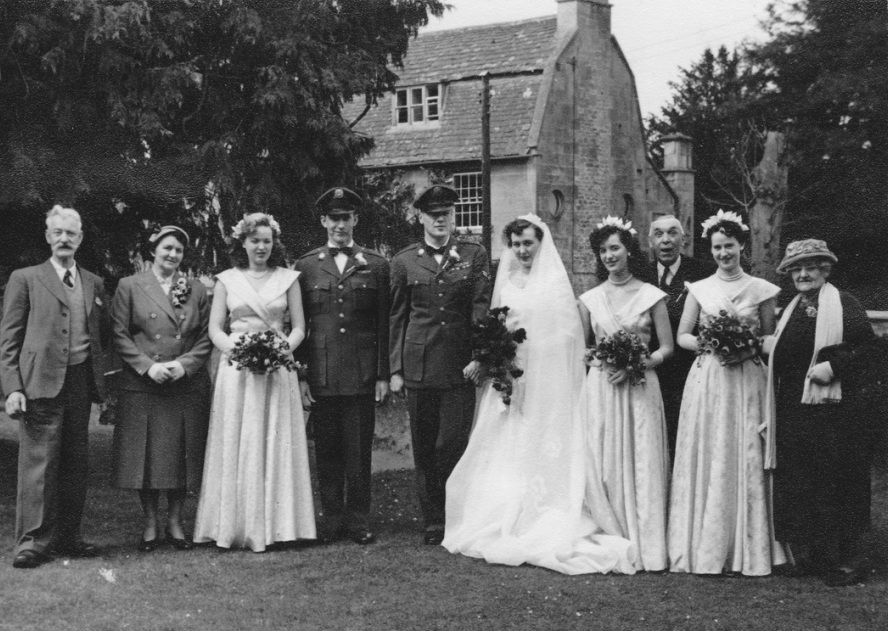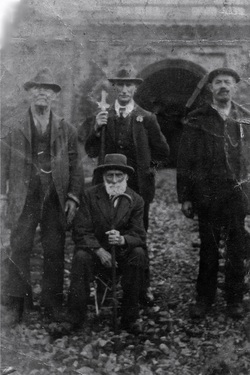
Cannings Family Story
Janice Cannings tells the story of her railway family back to 1811
April 2014
This picture of a gang of engineers outside Box Tunnel is fascinating for several reasons.
It shows Janice's grandfather, Ganger George Cannings, on the right.
Ex-ganger Morgan is on the left and ex-ganger Hunt is seated.
The photo was taken by Rev Vere Awdry, the author of Thomas the Tank Engine stories
in 1926 (photo courtesy Great Western Railway Magazine)
Photos indebted to Cannings family
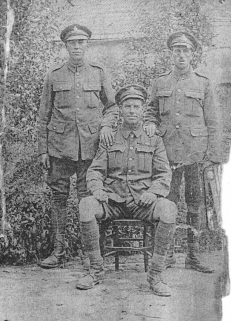 Samuel (left) on leave in Great War
Samuel (left) on leave in Great War
My Parents
Samuel Cannings, my father, was the eldest of four boys. Samuel was Chief Traffic Inspector at Bath Spa railway station; Arthur was a GWR train driver; Fred was a signalman at Box Station; and Ernest was a yard foreman at Birmingham.
Samuel married my mother, Florence, who was from London. She also worked on the railway at Paddington Station as a telephonist and telegrapher.
In the Great War he joined up in 1915 aged 20 and served in the Royal Garrison Artillery. He occasionally spoke of the conditions.
At times he was up to his waist in cold water in the trenches and he was mustard gassed and went for treatment to St Andrews Hospital.
Samuel Cannings, my father, was the eldest of four boys. Samuel was Chief Traffic Inspector at Bath Spa railway station; Arthur was a GWR train driver; Fred was a signalman at Box Station; and Ernest was a yard foreman at Birmingham.
Samuel married my mother, Florence, who was from London. She also worked on the railway at Paddington Station as a telephonist and telegrapher.
In the Great War he joined up in 1915 aged 20 and served in the Royal Garrison Artillery. He occasionally spoke of the conditions.
At times he was up to his waist in cold water in the trenches and he was mustard gassed and went for treatment to St Andrews Hospital.
In the Second World War my father was a railway inspector at Thingley Junction. One time a German reconnaissance plane attacked and there were bullets bouncing off the rails close to trucks fully loaded with armaments. My father wasn't as worried as others because of his experiences in the First World War.
He was on his way to work at Thingley by motorbike when a Marine lorry knocked him off his motorbike at Station Road, Corsham. Dr Bastow feared that he would never walk again. A very helpful British Legion officer, Captain Leggart, asked if he required any help. My father was in the RUH hospital at Bath for a year, then went to Chippenham Cottage hospital for recuperation.
My father had tremendous willpower and he built a platform on a bike to help rehabilitation. As well as doing his railway job, he grew vegetables on his land and after the accident he bought a plough to help him cultivate the land. He had three greenhouses with tomatoes and cucumbers and he kept geese, ducks, chickens and pigs. So in wartime we were more or less self sufficient.
My father enjoyed a glass of Guinness every day and died in 1984 aged 88. He had started work for the railway in 1920 as a porter, was promoted to be a passenger shunter and later chief inspector before retiring in 1960 having completed 40 years service.
He was on his way to work at Thingley by motorbike when a Marine lorry knocked him off his motorbike at Station Road, Corsham. Dr Bastow feared that he would never walk again. A very helpful British Legion officer, Captain Leggart, asked if he required any help. My father was in the RUH hospital at Bath for a year, then went to Chippenham Cottage hospital for recuperation.
My father had tremendous willpower and he built a platform on a bike to help rehabilitation. As well as doing his railway job, he grew vegetables on his land and after the accident he bought a plough to help him cultivate the land. He had three greenhouses with tomatoes and cucumbers and he kept geese, ducks, chickens and pigs. So in wartime we were more or less self sufficient.
My father enjoyed a glass of Guinness every day and died in 1984 aged 88. He had started work for the railway in 1920 as a porter, was promoted to be a passenger shunter and later chief inspector before retiring in 1960 having completed 40 years service.
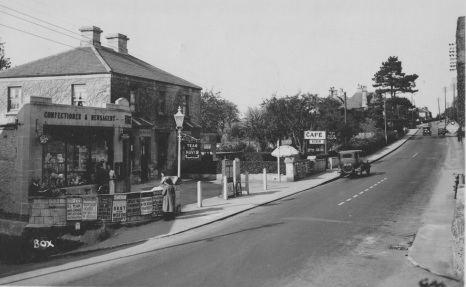 Box Post Office in 1935 (Carol Payne)
Box Post Office in 1935 (Carol Payne)
Life in Wartime Conditions
I remember that there were a lot of foreign servicemen in Box during the Second World War.
German PoWs (Prisoners of War) used to work on outlying farms and were brought down to Box by van. They used to go to Mrs Gray's Cafe at the foot of Chapel Lane where Miller's now is.
My mother didn't like me going down to the cafe. Italian prisoners used to walk around the village in two's and they always had a red patch on their backs.
I remember that there were a lot of foreign servicemen in Box during the Second World War.
German PoWs (Prisoners of War) used to work on outlying farms and were brought down to Box by van. They used to go to Mrs Gray's Cafe at the foot of Chapel Lane where Miller's now is.
My mother didn't like me going down to the cafe. Italian prisoners used to walk around the village in two's and they always had a red patch on their backs.
Polish refugees used to live in hostels at Thornley Pitts, Hawthorne.[1] They were very polite and mixed in the village going to dances at the Bingham Hall. When the Polish refugees asked to dance with the girls, they used to click their heels and bow in respect.
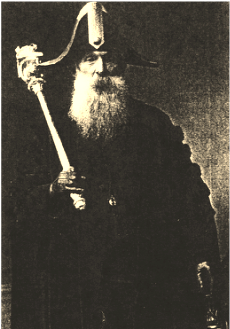
Great Uncle Bummy Pollard
One connection with this part of the country was my grandmother's brother, Charles B Pollard. He was a bailiff in Chippenham and Mace-bearer to the mayor there in 1897.
He was a bachelor and owned property all over Chippenham. He was always called Bummy Pollard.
I recall my mother telling me how her father brought her down to Chippenham to visit him when she was a very young girl. She witnessed the uncle when he had to evict a family with many children.
In those days if you owed money, that's what happened (no benefits then I suppose!).
One connection with this part of the country was my grandmother's brother, Charles B Pollard. He was a bailiff in Chippenham and Mace-bearer to the mayor there in 1897.
He was a bachelor and owned property all over Chippenham. He was always called Bummy Pollard.
I recall my mother telling me how her father brought her down to Chippenham to visit him when she was a very young girl. She witnessed the uncle when he had to evict a family with many children.
In those days if you owed money, that's what happened (no benefits then I suppose!).
My Grandparents
My father's father was George F Cannings, who started as a plate-layer for GWR. [2] Later he was a ganger (head of a gang of labourers) on the railway responsible for the maintenance of the line in the Box Tunnel. This mostly involved tapping the walls of the tunnel to ensure there were no loose bricks. The headline photo from the Great Western Railway Magazine of 1926 shows him with other gangers, Mr Morgan (left) and Mr Hunt (seated). The photo is also interesting because it was taken by the Rev Vere Awdry, author of Thomas the Tank Engine books.
Emmline, my father's mother, was the head cook at Box Vicarage when she married George. When they first married they lived at Ashley Farm with George's parents who owned the farmhouse and a pub. Then they moved to Pye Corner where Samuel, my father, was born.
George's mother Mary (who before her marriage was Miss Bullock, part of the family of clockmakers at Corsham) bought the whole row of cottages at Pye Corner and used to rent them out. Mary Bullock had married a businessman, a Mr Cannings, from Melksham. And they also bought other land around Box. The old orchard, that was once part of the land, still exists with panoramic views over the village.
My mother's father was in the Grenadier Guards and was an outrider to Queen Victoria. On his death, their mother (my grandmother) remarried and moved to Bristol to her new husband's home town; hence the family in the west.
My father's father was George F Cannings, who started as a plate-layer for GWR. [2] Later he was a ganger (head of a gang of labourers) on the railway responsible for the maintenance of the line in the Box Tunnel. This mostly involved tapping the walls of the tunnel to ensure there were no loose bricks. The headline photo from the Great Western Railway Magazine of 1926 shows him with other gangers, Mr Morgan (left) and Mr Hunt (seated). The photo is also interesting because it was taken by the Rev Vere Awdry, author of Thomas the Tank Engine books.
Emmline, my father's mother, was the head cook at Box Vicarage when she married George. When they first married they lived at Ashley Farm with George's parents who owned the farmhouse and a pub. Then they moved to Pye Corner where Samuel, my father, was born.
George's mother Mary (who before her marriage was Miss Bullock, part of the family of clockmakers at Corsham) bought the whole row of cottages at Pye Corner and used to rent them out. Mary Bullock had married a businessman, a Mr Cannings, from Melksham. And they also bought other land around Box. The old orchard, that was once part of the land, still exists with panoramic views over the village.
My mother's father was in the Grenadier Guards and was an outrider to Queen Victoria. On his death, their mother (my grandmother) remarried and moved to Bristol to her new husband's home town; hence the family in the west.
Addendum
Father: Samuel Cannings born 7th October 1895; married Florence; died January 1984; children Delme, Robert, Janice, Elsie
Grandfather: George F Cannings b.1866; m.Emmline b.1870; d.June 1929; c.Samuel, Frederick J, Arthur James, Ernest
Great-Grandfather: James Cannings b.1811; m.Mary Bullock b.1824; d.?; c.Grace, James, Samuel, George F
Father: Samuel Cannings born 7th October 1895; married Florence; died January 1984; children Delme, Robert, Janice, Elsie
Grandfather: George F Cannings b.1866; m.Emmline b.1870; d.June 1929; c.Samuel, Frederick J, Arthur James, Ernest
Great-Grandfather: James Cannings b.1811; m.Mary Bullock b.1824; d.?; c.Grace, James, Samuel, George F
References
[1] Kevin Ford recalls a similar circumstance in 1956 when Hungarian refugees were housed at Thorney Pitts after the uprising against Russian control had been ruthlessly put down: I once looked through the window and saw them. There was Joe Bugner there (British heavyweight boxer who once fought Muhammad Ali). They did traditional dancing. There are only about 3 prefabs left there now.
[2] For more details see http://www.theplatelayers.org/pltname.htm
[1] Kevin Ford recalls a similar circumstance in 1956 when Hungarian refugees were housed at Thorney Pitts after the uprising against Russian control had been ruthlessly put down: I once looked through the window and saw them. There was Joe Bugner there (British heavyweight boxer who once fought Muhammad Ali). They did traditional dancing. There are only about 3 prefabs left there now.
[2] For more details see http://www.theplatelayers.org/pltname.htm
